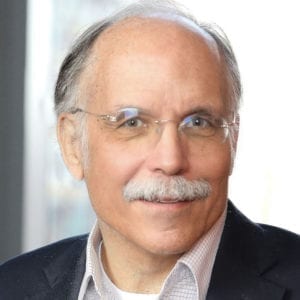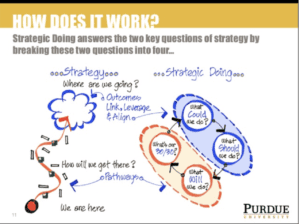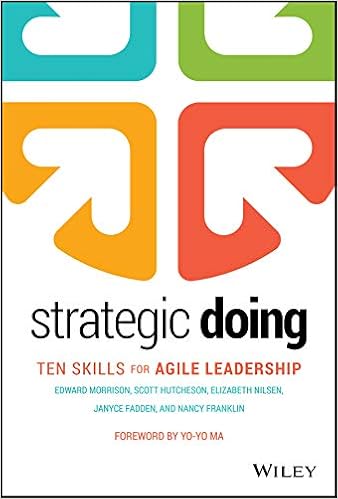Note: We re-aired this episode interview in January 2024. For the most recent version, with more detailed show notes and a transcript, see “Redux: Strategic Doing with Ed Morrison.”

For over 25 years Ed Morrison, founder and director of the Agile Strategy Lab at Purdue University, has been studying challenges related to how humans collaborate and engage in complex work. In that time, he pioneered the development of Strategic Doing, a new approach to strategy and complex collaboration in open, loosely connected networks.
He is also a co-author of Strategic Doing: Ten Skills for Agile Leadership, which outlines this new discipline of leadership strategy with practical ways to unleash the power of collaborative networks.
In this episode of the Leading Learning Podcast, Celisa talks with Ed about the Strategic Doing protocol including its key features, examples of related skills and tools, and specific ways learning businesses can apply it to improve collaboration.
To tune in, just click below. To make sure you catch all of the future episodes, be sure to subscribe by RSS, Apple Podcasts, Spotify, Stitcher Radio, iHeartRadio, PodBean, or any podcatcher service you may use (e.g., Overcast). And, if you like the podcast, be sure to give it a tweet!
Listen to the Show
Read the Show Notes
[00:18] – A preview of what will be covered in this episode where Celisa interviews Ed Morrison, director of the Agile Strategy Lab at Purdue University.
Reflection Questions

[01:42] – You might consider the reflections questions below on your own after listening to an episode, and/or you might pull a team together, using part or all of the podcast episode for a group discussion.
- Listen to Ed’s thoughts on appreciative framing questions. How might you reframe the questions you consider in your organization to focus more on opportunities and hypotheses than on problems? What verbal jujitsu do you need to do?
- Pay attention to Ed’s explanation of the Big Easy. Are there decisions you need to make, decisions that involve a big group of stakeholders, where you might use the Big Easy tool to arrive at a path forward?
[02:44] – Introduction to Ed and some additional information about his background.
What is Strategic Doing?
[04:11] – Because it’s been the cornerstone of your career for so many years and because it’s the focus of your book, would start by telling listeners what Strategic Doing is and how it came to be?
Ed describes Strategic Doing as a protocol; a way of thinking about collaboration that enables people to form collaborations quickly, move them towards measurable outcomes, and then learn and make adjustments as they learn by doing.
It came about through work (starting in the 1980’s) where he was dealing with complex challenges in communities, big and small, facing the challenges of globalization. He says that globalization really started undermining the economies of a lot of communities and regions who were focused on how to adjust to this new world of global competition. Part of the challenge of course, was bringing people together.
And the only real approach we had at the time was strategic planning, which Ed had learned in his corporate strategy work and had applied. But the problem with these big planning models, he points out, is they don’t work very well in situations where nobody can really tell anybody what to do.
Ed talks about how in the early 90’s he started exploring a new approach to strategy based on open source software development. In 2005 he was convinced he had a model in his head that he could replicate, but he didn’t know how to teach it. So he came to Purdue to learn how to do that and he’s been there ever since.
Appreciative Framing Questions
[06:23] – Collaboration is core to Strategic Doing, and collaboration involves conversation. In the book, Strategic Doing, you and your four co-authors name and unpack 10 skills needed for collaboration. We won’t, of course, be able cover all 10 skills in our conversation today, but I’m hoping we can touch on a couple of them.
In particular, one of them focuses on using appreciative framing questions to design a conversation. Can you talk a little about what that means and maybe even what kind of appreciative questions learning leaders might ask or how we might arrive at those questions?
Ed explains that complex collaborations emerge out of a conversation that has an underlying structure and trajectory that changes over time. But part of the challenge is to frame the conversation and draw a boundary around the conversation that we want to have.
And it’s critical that this conversation be appreciative. This is because we’re dealing with really complex challenges—collaboration is a complex, emergent phenomenon that emerges out of our conversations. So one of the challenges that we want to focus on initially is how to frame the conversation so that we’re looking at opportunities, not problems.
Ed points out that if we focus on challenges and frame them around problems, we typically frame the problems and they connect with each other. He shares an example of how using problem-centered conversations often lead to going nowhere/talking about more problems. However, when you reframe a conversation into an opportunity, people can start thinking about how to design and move toward a solution.
He notes this is very tightly bound up with insights of appreciative inquiry, which shows that people move in the direction of their conversations. So Strategic Doing is designed to enable us to design a future that we can’t see yet but it’s an opportunity to design something that produces something valuable for us.
Ed says they’ve learned that framing questions start with some fairly simple constructions. One of the ways to think about it is to start with “how could we” or “imagine if”,or “what would it look like if”.
He shares an example of a professor who learned to take problem statements, flip them around—do a little “verbal jujitsu” on them—to use this strategy and how by doing that, he opened up the door to more productive conversations with his colleagues.
So frame the conversation, use the framing question as an attractor or as an invitation to conversation, and invite people into that conversation to think about a future that we can jointly work together and design together.
See our related interview about the important role of conversations in leadership, Spanning Leadership and Learning with Dr. Wanda Wallace.
Sponsor: Community Brands
[13:09] – If you are looking for technology to help design your organization’s future and help you focus on opportunities, check out our sponsor for this quarter.
Community Brands provides a suite of cloud-based software for organizations to engage and grow relationships with the individuals they serve, including association management software, learning management software, job board software, and event management software. Community Brands’ award-winning Crowd Wisdom learning platform is among the world’s best LMSes for corporate extended enterprise and is a leading LMS for association-driven professional education programs. Award-winning Freestone, Community Brands’ live event learning platform, is a leading platform for live learning event capture, Webinars, Webcasts, and on-demand streaming.
Appreciative Framing Questions for Learning Businesses
[14:09] – A discussion about how learning businesses might be able to use appreciative framing questions.
Examples Ed shares are:
- Imagine we had a conference, in which people came seeking powerful learning experiences that they both created and shared? What would that look like?
- How could we create memorable learning experiences for everyone every month, not just once a year?
- What would it look like if our organization became a test bin for the latest ideas in adult learning?
These types of questions help you trigger some imagination on the part of the potential participants in your conversations and you’re inviting them to design a future that you can’t really see yet, but you think it’s out there. So it embeds a hypothesis about a future that you could work on together.
And the idea of the hypothesis is that you’re going to go out and test it, which is part of the emphasis on doing—so ultimately you’ll move beyond the conversation.
Ed says you have to do this because by definition, collaboration is an environment in which nobody can really tell anybody what to do, and you’re working towards shared value/outcomes. And you don’t know how that’s going to unfold—you can’t predict the future. But you think it’s there, that you can create value together that you couldn’t create by yourselves, and you have to then start running experiments.
As you run these experiments and start doing things together (in what he calls microcommitments), then you start building trust across the network—and that’s what really starts to move the network forward.
The Big Easy
[16:46] – Another skill needed for agile leadership is making decisions, making choices, sorting through the many options that might be taken and picking the one that has the best chance of success. And you have a tool for doing that. Would you talk about the 2×2 matrix and the Big Easy flavor of that?
Ed discusses how they designed Strategic Doing to think about networks and how to build them and do things together in a linked, leveraged, and aligned way, all of us taking small steps, growing the network, and moving it towards an outcome that we can’t see yet.
The whole notion of this is linking and leveraging across your networks and engaging people in your networks to work with you on projects they would find valuable as well. We can come up with all sorts of great ideas, but Ed says the challenge is narrowing those down/figuring out what to do next—and that’s how they came up with the idea of the Big Easy.
The reason we want to evaluate our ideas and want two dimensions is because we want to engage other people in this work. So the big idea is one that creates a sense of transformation. It’s something that people can get excited about.
On the first dimension, they ask people to rank on a 1-5 scale how big of an idea it is—will it get us closer to answering our framing question?
On the second dimension, they also need to be developing “small winds”. Ed points out that people won’t want to hang around if we’re just talking—we have to actually do things. Developing small winds involves pragmatism and coming up with practical ideas. So they ask (again on a 5 point scale), how easy the idea will be to start to implement/generate small winds.
This helps you figure out the balance point between a big idea and an easy idea. By asking your participants to do this in an open session, you’re creating a transparent way to do a fairly sophisticated analysis of these opportunities to rank them.
So the Big Easy is the idea that comes out with the highest score. Ed says what you’re tapping into here is strategic intuition.
In strategic planning, intuition has no role—it’s all analytic, based on numbers and facts. But if we’re dealing with complex environments with open networks, we can’t analyze and predict them.
The Big Easy creates a very fast way to evaluate a range of ideas and to start to put them in an order. Ed shares a couple examples of this.
But he says it’s basically a way that you can quickly capture the intuition of the group and you can do it in a transparent, open, and fair way, which is very important. When people don’t know how decisions have been made, it doesn’t generate much trust within the organization. But if you can make it transparent and people can see what others are voting, a sense of trust begins to build.
Another interesting insight Ed offers is that it allows everyone to look at each opportunity from different perspectives and understand why others may have voted differently than you. This shows you where deeper conversations may need to be had but reminds us we are all looking at the world through our own straw. And when we listen to one another we’re building trust, awareness, and learning about the different points of view across the table—and by making these conversations deeper, we actually bring people together.
Agile Leadership: Collective Benefit of Skills and Role of Teams
[25:53] – Will you talk a bit about both the benefit of using the skills in concert, versus employing a single skill, and about the role of teams or groups in agile leadership?
Ed starts by addressing the role of teams. He says there are 10 skills but nobody is good at all of them and explains teams using the S curve—the whole notion that living systems go through a period of birth, rapid growth, maturity, and then decline.
Teams/people can be situated along an S curve. In other words, you have entrepreneurs who are at the early stages of the S curve and are very horizontal thinkers, thinking in new and different ways. And you have people at the top of the S curve that are really focused on efficiency. Ed says this is all part of the notion of cognitive diversity and their 10 skills actually map pretty closely to an S curve.
One of the things they’ve learned is that when we’re facing these complex challenges (a transformation of any sort is complex), we’re dealing with hidden networks we can’t see and we’re trying to align assets within those networks, link and leverage them, and move them in a new direction. And you need a cognitively diverse team with people who are good at all these different skills.
Ed discusses the importance of recognizing that you’re not good at all the 10 skills and that you need complements. And you need to recognize when their leadership matters.
He offers background on how they came to the 10 rules and explains how it started when we was looking for a good definition of strategy, something important to Ed since he is a lawyer by training.
A definition for strategy he came across that really made a lot of sense was from Kathleen Eisenhardt (Stanford University) and it says that strategy answers two questions:
- Where are we going?
- How will we get there?
The next challenge he faced was how to design a conversation that answered both of those questions. So they came up with four questions:
- What could we do?
- What should we do? (the question of the Big Easy)
- What will we do?
- What’s our 30/30?(when are we getting back together in roughly 30 days to figure out what we learned and what we’re going to do in the next 30 days)
Ed explains that first two questions give us an outcome and the second two give us a pathway. So we can structure a conversation around four questions and come up with a strategic action plan. And one level down deeper, behind those four questions are the 10 skills.

The 10 skills enable you to design and manage that entire process of building a strategic action plan or collaboration plan going forward. This is really where the practice meets the research and if you really want to learn Strategic Doing beyond what you can read in the book, you’ll probably want to know why these 10 skills work.
Ed says that the 10 skills are simple in the sense that they are common sense. But they require practice to master just like any discipline. He shares an example of how they were ultimately able to teach these skills (which was his goal), write the book, and now make it an open source discipline to share across universities.
He also recommends that when you get really good at this, you end up applying these skills not only in a big process, but you can also pull particular strategies out individually to use as needed.
[36:12] – What is one of the most powerful learning experiences you’ve been involved in, as an adult, since finishing your formal education?
Ed talks about his experience attending their first Strategic Doing practitioner conference about four years ago and how he walked away with three or four cool ideas. Considering he’d been thinking about the topic for 25 years, he’s amazed that he can still walk away with new ideas. He also shares how exciting and inspiring it is because of the ways he’s able to see deeper and deeper levels of application for this.
It’s noted this experience highlights the power of peer/social learning as well.
[40:44] –How to connect with Ed and/or learn more about Strategic Doing:
- Website (Strategic Doing Institute): https://strategicdoing.net
- LinkedIn: Ed Morrison
[41:43] – Wrap-Up
Reflection Questions

- How might you reframe the questions you consider in your organization to focus more on opportunities and hypotheses than on problems? What verbal jujitsu do you need to do?
- Are there decisions you need to make that involve many stakeholders where you might use the Big Easy to arrive at a path forward?
If you are getting value from the Leading Learning podcast, be sure to subscribe by RSS, Apple Podcasts, Spotify, Stitcher Radio, iHeartRadio, PodBean, or any podcatcher service you may use (e.g., Overcast).
We’d also appreciate if you give us a rating on Apple Podcasts by going to https://www.leadinglearning.com/apple. We personally appreciate your rating and review, but more importantly reviews and ratings play a big role in helping the podcast show up when people search for content on leading a learning business.
And we would be grateful if you check out our sponsor for this quarter. Find out more about Community Brands.
Finally, consider following us and sharing the good word about Leading Learning. You can find us on Twitter, Facebook, and LinkedIn. We also encourage you to use the hashtag #leadinglearning on each of those channels. However you do it, please do follow us and help spread the word about Leading Learning.
[43:52] – Sign off
See Also:



 The Art and Science of Effective Feedback
The Art and Science of Effective Feedback
I love that you’ve added reflection questions at the beginning of your podcasts. This is such a great way to focus the listener/learner on what she can take away/use from the content. When you first added these, did you do any discussion/explanation of why you did it?
I’m thinking of promoting this technique with some of our education projects and would love to share some background on the reasoning with our speakers and other stakeholders.
Hey, Carol – Thanks for commenting. So glad you find the reflection questions helpful. We didn’t say a great deal about why we introduced them (in episode 201), though we did comment that we felt it would help listeners better process the wealth of information provided through the interviews.
We also felt it would make it easier for teams/groups to have a basis for discussing episodes, as we are advocates of this and have heard from organizations that do use episodes for team learning.
Finally, as you know, we are big advocates of reflection, in general, as a learning tool. Frankly, we should have thought of this much sooner, but sometimes 200 episodes is what is required!
Jeff
Great podcast – thanks Jeff for introducing me to Strategic Doing. I was just wrapping up a strategic positioning and roadmap document when I listened to this and so I read the book to identify tips for moving from planning to action. While the context of open loosely connected networks doesn’t entirely match my situation, the book and its concepts were still highly relevant. What I plan to do differently, that I might not have otherwise, includes: (1) agile leadership: focus on the roadmap in short-term segments. I’m going to try 90 days, rather than trying to tackle a year at a time. (2) shared leadership; the identification of action items for each quarter to be led the team, rather than me setting them all. In truth, I’m identifying the first quarter’s activities, but from there I intend to have team members identify what they will focus on next and why. There may be a little negotiation…